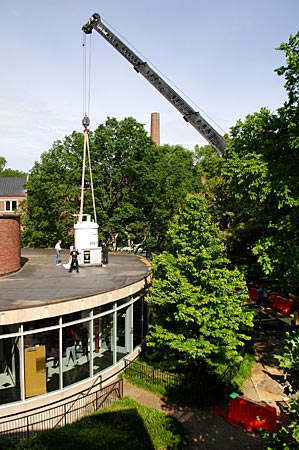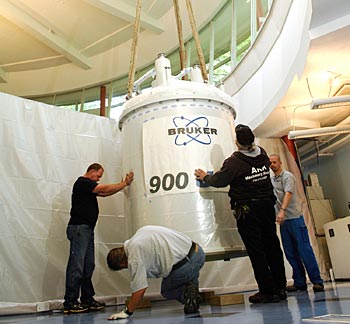
Onlookers cheered on the morning of Saturday, May 7, as a shattering champagne bottle christened the delivery of a $5 million, 7.5-ton magnet to Vanderbilt University.
The magnet is the main part of an ultra-high field, 900 megahertz nuclear magnetic resonance (NMR) spectrometer that will help researchers solve the mysteries of cancer, Alzheimer’s disease and other disorders.
Standing 9.5 feet tall, the nearly 6-foot wide white cylinder was gingerly lowered by crane through an opening in the roof of the Biomolecular NMR Facility — with just 4 inches of clearance.
The arrival of the magnet “is a big moment for chemistry and structural biology at Vanderbilt,” said Michael Stone, chair of Chemistry, who uses NMR to study how DNA is damaged by mutagenic chemicals. “I think it’s going to enable us to do science that is really on the cutting edge.”
The instrument consists of superconducting alloy wire which, when cooled by liquid helium to near absolute zero, has essentially no resistance and therefore can generate an extremely high magnetic field, Stone said.
Once it’s up and running this summer, it will be one of about 10 such devices in operation the United States. Its application at Vanderbilt to cancer drug discovery may be unique, faculty members said.

The spectrometer’s high magnetic field leads to the production of detailed 3-D “pictures” on the molecular level that can reveal the structure of large, complex molecules or of smaller, drug-like molecules binding to disease-related proteins.
In the latter case, this information can help scientists “optimize” the molecules so they bind more strongly and specifically to their targets and have a better chance of becoming new drugs, said Stephen Fesik, the Orrin H. Ingram II Chair in Cancer Research, professor of Biochemistry, Pharmacology and Chemistry, and leader of Vanderbilt’s cancer drug discovery program.
“Think of an old-fashioned watch that has many tiny little pieces,” explained Charles Sanders, professor of biochemistry who uses NMR to determine the structure of large membrane proteins associated with human disorders such as abnormal heart rhythms.
“Trying to fix a protein that’s broken in a disease without knowing the structure is like trying to fix a watch without being able to see (inside),” he said. “You have to be able to see what it is you’re trying to fix.”
Paul Barrett, a third-year graduate student in Sanders’ lab, said he hopes the new instrument will enable his group to be the first to determine the structure of C99, a membrane protein involved in the development of Alzheimer’s disease.
“By using the new ‘900,’ we’ll really be able to get some great information on the structure, dynamics and function of this protein,” Barrett said. “[rquote]It will be a great foundation of knowledge for understanding how Alzheimer’s disease begins.[/rquote]”
Sanders is principal investigator of a $3.9 million stimulus grant awarded in 2009 by the National Science Foundation to buy the spectrometer. The university renovated the circular Biomolecular NMR Facility that houses the instrument, and the medical center covered the remaining costs, said Markus Voehler, research assistant professor of Chemistry and the facility’s director of operations.
Vanderbilt’s success in obtaining the grant owes a lot to Walter Chazin, the Chancellor’s Professor of Biochemistry and Chemistry, and the “world-class” Center for Structural Biology he directs, Sanders said.
Saturday’s delivery also exemplifies the university’s “visionary leadership,” which is willing to invest in the future, and its collaborative environment, which encourages scientists to work together across disciplines, he and Fesik pointed out.
“There’s a really good chance that in 10 years Vanderbilt’s going to be a leader in taking structural biology information . . . and translating that into therapeutic discoveries,” Sanders predicted. “And that’s pretty exciting.”